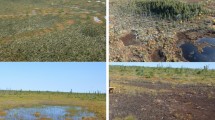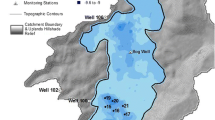Abstract
At Big Run Bog, aSphagnum-dominated peatland in the unglaciated Appalachian Plateau of West Virginia, significant spatial variation in the physical and chemical properties of the peat and in surface and subsurface (30 cm deep) water chemistry was characterized. The top 40 cm of organic peat at Big Run Bog had average values for bulk density of 0.09 g · cm−3, organic matter concentration of 77%, and volumetric water content of 88%. Changes in physical and chemical properties within the peat column as a function of depth contributed to different patterns of seasonal variation in the chemistry of surface and subsurface waters. Seasonal variation in water chemistry was related to temporal changes in plant uptake, organic matter decomposition and element mineralization, and to varying redox conditions associated with fluctuating water table levels. On the average, total Ca, Mg, and N concentrations in Big Run Bog peat were 33, 15, and 1050 μmol · g−1, respectively; exchangeable Ca and Mg concentrations were 45 and 14 μeq · g−1 , respectively. Surface water pH averaged 4.0 and Ca++ concentrations were less than 50 μeq · L−1 . These chemical variables have all been used to distinguish bogs from fens. Physiographically, Big Run Bog is a minerotrophic fen because it receives inputs of water from the surrounding forested upland areas of its watershed. However, chemically, Big Run Bog is more similar to true ombrotrophic bogs than to minerotrophic fens.
Similar content being viewed by others
References
Boelter, D.H. 1965. Hydraulic conductivity of peats. Soil Science 100: 227–231.
Boelter, D.H. 1968. Important physical properties of peat materials. In: Proceedings of the Third International Peat Congress. Quebec, Canada. pp 150–154.
Boelter, D.H. and G.R. Blake. 1964. Importance of volumetric expression of water contents of organic soils. Soil Science Society of America Proceedings 28: 176–178.
Braekke, F.H. 1981. Hydrochemistry in low-pH-soils of South Norway. 1. Peat and soil water quality. Reports of the Norwegian Forest Research Institute 36 (11): 1–32.
Cameron, C.C. 1968. Peat. In: Mineral resources of the Appalachian region. U.S. Geological Survey Professional Paper 580. pp 136–145.
Chapman, S.B. 1964. The ecology of Coom Rigg Moss, Northumberland. II. The chemistry of peat profiles and the development of the bog system. Journal of Ecology 52: 315–321.
Chapman, S.B. 1965. The ecology of Coom Rigg Moss, Northumberland. III. Some water relations of the bog system. Journal of Ecology 53: 371–384.
Cronan, C.S. 1979. Determination of sulfate in organically colored water samples. Analytical Chemistry 51: 1333–1335.
Damman, A.W.H. 1978. Distribution and movement of elements in ombrotrophic peat bogs. Oikos 30: 480–495.
Damman, A.W.H. 1979. Geographic patterns in peatland development in eastern North America. In: Proceedings of the International Symposium on Classification of Peat and Peatlands. Hyytiala, Finland. International Peat Society. pp 42–57.
Diehl, J. 1981. Geologic factors affecting the formation and presence of wetlands in the north central section of the Allegheny Plateau section of West Virginia. Thesis. West Virginia University, Morgantown.
Farnham, R.S. and D.N. Grubich. 1970. Peat resources of Minnesota. Potentially report. Fens bog area, St. Louis County, Minnesota. Iron Range Resources and Rehabilitation, St. Paul, Minnesota.
Finney, H.R., E.R. Gross and R.S. Farnham. 1974. Limnic materials in peatlands of Minnesota. In: A.R. Aandahl, S.W. Buol, D.E. Hill and H.H. Bailey (eds.), Histosols: their characteristics, classification, and use. Soil Science Society of America Special Publication No. 6. Madison, Wisconsin. pp 21–31.
Gore, A.J.P. and S.E. Allen. 1956. Measurement of exchangeable and total cation content for H+, Na+, K+, Mg2+, Ca2+, and iron in high level blanket peat. Oikos 7: 48–55.
Gorham, E. 1967. Some chemical aspects of wetland ecology. Technical Memorandum. National Research Council of Canada, Associated Committee on Geotechnical Research, No. 90:20–38.
Horton, D.G., D.H. Vitt and N.G. Slack. 1979. Habitats of circumboreal-subarctic sphagna: I. A quantitative analysis and review of species in the Caribou Mountains, northern Alberta. Canadian Journal of Botany 57: 2283–2317.
Hough, A.F. 1945. Frost pocket and other microclimates in forests of the northern Allegheny Plateau. Ecology 26: 235–250.
Kaila, A., J. Koylijarvi and E. Kivinen. 1953. Influence of temperature upon the mobilization of nitrogen in peat. Journal of the Scientific Agricultural Society of Finland 25: 37–46.
Kivekas, J. and A. Kaila, 1957. Extractable calcium, magnesium, potassium, and sodium in different peat types. Journal of the Scientific Agricultural Society of Finland 29: 41–55.
Klopatek, J.M. 1978. Nutrient dynamics of freshwater riverine marshes and the role of emergent macrophytes. Pages 195–216 In: R.E. Good, D.F. Whigham and R.L. Simpson (eds.), Freshwater wetlands: Ecological processes and management potential. pp 195–216. Academic Press, New York.
Korpijaakko, M. and N.W. Radforth. 1972. Studies on the hydraulic conductivity of peat. In: Proceedings of the Fourth International Peat Congress, Helsinki, Finland. pp 323–334.
Lang, G.E. and B.R. McDonald. 1982. Loss of mass and elemental changes in decomposing sedge and alder leaves. In: B.R. McDonald (ed.), Symposium on Wetlands of the Unglaciated Appalachian Region. West Virginia University, Morgantown. pp 55–62.
Likens, G.E. and F.H. Bormann. 1970. Chemical analyses of plant tissues from the Hubbard Brook ecosystem in New Hampshire. Yale University School of Forestry Bulletin No. 79. New Haven, Connecticut.
Livett, E.A., J.A. Lee and J.H. Tallis. 1979. Lead, zinc, and copper analyses of British blanket peats. Journal of Ecology 67: 865–891.
Losche, C.K. and W.W. Beverage. 1967. Soil survey of Tucker County and part of northern Randolph County, West Virginia. United States Department of Agriculture, Soil Conservation Service, United States Forest Service, and West Virginia Agricultural Experiment Station.
Moore, P.D. and D.J. Bellamy. 1974. Peatlands. Springer-Verlag, New York.
Mornsjo, T. 1968. Stratigraphical and chemical studies on two peatlands in Scania, South Sweden. Botaniska Notiser 21: 343–360.
National Atmospheric Deposition Program. 1981. NADP Report: Precipitation Chemistry; First, second, third, and fourth quarters 1980. Natural Resource Ecology Laboratory, Colorado State University, Fort Collins, Colorado.
National Oceanic and Atmospheric Administration 1946–1950, 1952–1981. Climatological data. Annual Summaries. West Virginia. Environmental Data and Information Service, National Climatic Center, Asheville, North Carolina.
Odelein, M., A.R. Selmer-Olsen and I. Haddeland. 1975. Investigations of some red-ox processes in peat and their influences on run-off water. Acta Agriculturae Scandinavica 25: 161–166.
Richardson, C.J., D.L. Tilton, J.A. Kadlec, J.P.M. Chamie and A.W. Wentz. 1978. Nutrient dynamics of northern wetland ecosystems. In: R.E. Good, D.F. Whigham and R.L. Simpson (eds.), Freshwater wetlands: Ecological processes and management potential. pp 217–241. Academic Press, New York.
Rippon, J.E., R.A. Skeffington, M.J. Wood, K.A. Brown and D.J.A. Brown. 1980. Hydrogen, sulfur, and nitrogen budgets in soils and catchments. In: D. Drablos and A. Tollan (eds.), Proceedings of the International Conference on the Ecological Impact of Acid Precipitation. SNSF Project, Oslo, Norway. pp 276–277.
Smith, W.H. 1976. Character and significance of forest tree root exudates. Ecology 57: 324–331.
Snedecor, G.W. and W.G. Cochran. 1978. Statistical methods. Iowa State University Press, Ames, Iowa. Sixth edition.
Sonesson, M. 1970. Studies on mire vegetation in the Tornetrask area, northern Sweden. IV. Some habitat conditions of the poor mires. Botaniska Notiser 123: 67–111.
Technicon Industrial Systems. 1977. Industrial methods No. 98-70 W/A, No. 99-70 W/B, No. 100-70 W, No. 240-72 W. Technicon Industrial Systems, Tarrytown, New York.
Thornthwaite, C.W. 1948. An approach toward a rational classification of climate. Geographical Review 38: 55–94.
United States Department of Agriculture. 1972. Soil survey laboratory methods and procedures for collecting soil samples. Soil Conservation Service. Soil Survey Investigations Report No. 1. Washington, D.C.
Vitt, D.H., P. Achuff and R.E. Andrus. 1975. The vegetation and chemical properties of patterned fens in the Swan Hills, north central Alberta. Canadian Journal of Botany 53: 2776–2795.
Walbridge, M.R. 1982. Vegetation patterning and community distribution in four high-elevation headwater wetlands in West Virginia. Thesis. West Virginia University, Morgantown.
Walbridge, M.R. and G.E. Lang. 1982. Major plant communities and patterns of community distribution in four wetlands of the unglaciated Appalachian Region. In: B.R. McDonald (ed.), Symposium on Wetlands of the Unglaciated Appalachian Region. West Virginia University, Morgantown. pp 131–142.
Waughman, G.J. 1980. Chemical aspects of south German peatlands. Journal of Ecology 68: 1025–1046.
Weedfall, R.O. and W.J. Dickerson. 1965. The climate of the Canaan Valley and Blackwater Falls State Park, West Virginia Climatography of the United States No. 20-46-2. West Virginia Agricultural Experiment Station Current Report 43. West Virginia University, Morgantown.
Weedfall, R.O. and W.J. Dickerson. 1965. The climate of the Canaan Valley and Blackwater Falls State Park, West Virginia. Climatography of the United States No. 20-46-2. West Virginia Agricultural Experiment Station Current Report 43. West Virginia University, Morgantown.
Wieder, R.K. 1982. Biogeochemical relationships inSphagnum-dominated wetlands in West Virginia. Dissertation. West Virginia University, Morgantown.
Wieder, R.K. and G.E. Lang. 1983. Net primary production of the dominant bryophytes in aSphagnum-dominated wetland in West Virginia. The Bryologist 86: 278–284.
Wieder, R.K., A.M. McCormick and G.E. Lang. 1981. Vegetational analysis of Big Run Bog, a nonglaciatedSphagnum bog in West Virginia. Castanea 46: 16–29.
Wildi, O. 1978. Simulating the development of peat bogs. Vegetatio 37:1–37.
Wright, R.F., and M. Johannessen. 1980. Input-output budgets of major ions at gauged catchments in Norway. In: D. Drablos and A. Tollan (eds.), Ecological impact of acid precipitation. SNSF Project, Oslo, Norway. pp 250–251.
Author information
Authors and Affiliations
Rights and permissions
About this article
Cite this article
Wieder, R.K. Peat and water chemistry at Big Run Bog, a peatland in the Appalachian mountains of West Virginia, USA. Biogeochemistry 1, 277–302 (1985). https://doi.org/10.1007/BF02187203
Issue Date:
DOI: https://doi.org/10.1007/BF02187203




